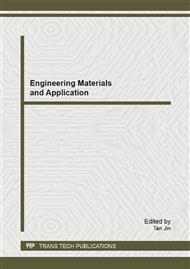[1]
D.B. Johnson, K.B. Hallberg, Biogeochemistry of the compost bioreactor components of a composite acid mine drainage passive remediation system, Sci. Total Environ. 338 (2005) 81-93.
DOI: 10.1016/j.scitotenv.2004.09.008
Google Scholar
[2]
O. Gibert, J. d. Pablo, J.L. Cortina, C. Ayora, Chemical characterisation of natural organic substrates for biological mitigation of acid mine drainage, Water Res. 38 (2004) 4186-4196.
DOI: 10.1016/j.watres.2004.06.023
Google Scholar
[3]
G.J. Zagury, V. Kulnieks, C.M. Neculita, Characterization and reactivity assessment of organic substrates for sulphate-reducing bacteria in acid mine drainage treatment, Chemosphere. 64 (2006) 944-954.
DOI: 10.1016/j.chemosphere.2006.01.001
Google Scholar
[4]
C.D. McCullough, M.A. Lund, Bioremediation of Acidic and Metalliferous Drainage (AMD) through organic carbon amendment by municipal sewage and green waste, J Environ Manage. 92 (2011) 2419-2426.
DOI: 10.1016/j.jenvman.2011.04.011
Google Scholar
[5]
I.S. Chang, P.K. Shin, B.H. Kim, Biological treatment of acid mine drainage under sulphate-reducing conditions with solid waste materials as substrate. Water Res. 34 (2000) 1269-1277.
DOI: 10.1016/s0043-1354(99)00268-7
Google Scholar
[6]
R.P. Choudhary, A.S. Sheoran, Comparative study of cellulose waste versus organic waste as substrate in a sulfate reducing bioreactor. Bioresour. Technol. 102 (2011) 4319-4324.
DOI: 10.1016/j.biortech.2010.08.126
Google Scholar
[7]
M.C. Costa, M. Martins, C. Jesus, et al. Treatment of acid mine drainage by sulphate-reducing bacteria using low cost matrices. Water Air Soil Pollution. 2008, 189: 149-162.
DOI: 10.1007/s11270-007-9563-1
Google Scholar
[8]
S. Foucher, F. Battaglia-Brunet, I. Ignatiadis, et al. Treatment by sulfate-reducing bacteria of Chessy acid-mine drainage and metals recovery. Chemical Engineering Science. 2001, 56 (4): 639-1645.
DOI: 10.1016/s0009-2509(00)00392-4
Google Scholar
[9]
C. Neculita, G.J. Zagury. Biological treatment of highly contaminated acid mine drainage in batch reactors: long-term treatment and reactive mixture characterization. Journal of Hazardous Materials. 2008, 157: 358-366.
DOI: 10.1016/j.jhazmat.2008.01.002
Google Scholar
[10]
G.J. Zagury, V.I. Kulnieks, C.M. Neculita. Characterization and reactivity assessment of organic substrates for sulphate-reducing bacteria in acid mine drainage treatment. Chemosphere. 2006, 64 (6): 944-954.
DOI: 10.1016/j.chemosphere.2006.01.001
Google Scholar
[11]
B.K. Winfrey, W.H. Strosnider, R.W. Nairn, K.A. Strevett, Highly effective reduction of fecal indicator bacteria counts in an ecologically engineered municipal wastewater and acid mine drainage passive co-treatment system, Ecol. Eng. 2010, 36: 1620-1626.
DOI: 10.1016/j.ecoleng.2010.06.025
Google Scholar
[12]
M.M.M. Goncalves, A.C.A. da Costa, S.G.F. Leite, G.L. SantAnna, Heavy metal removal from synthetic wastewaters in an anaerobic bioreactor using stillage from ethanol distilleries as a carbon source, Chemosphere , 2007, 69: 1815–1820.
DOI: 10.1016/j.chemosphere.2007.05.074
Google Scholar
[13]
M.T. Alvarez, C. Crespo, B. Mattiasson, Precipitation of Zn(II), Cu(II) and Pb(II) at bench-scale using hydrogen sulfide from the utilization of volatile fatty acids, Chemosphere, 2007, 66: 1677-1683.
DOI: 10.1016/j.chemosphere.2006.07.065
Google Scholar
[14]
O. Gibert, J. d. Pablo J.L. Cortina,C. Ayora. Chemical characterisation of natural organic substrates for biological mitigation of acid mine drainage, Water Research, 2004, 38: 4186-4196.
DOI: 10.1016/j.watres.2004.06.023
Google Scholar
[15]
G.J. Zagury, V. Kulnieks, C.M. Neculita, Characterization and reactivity assessment of organic substrates for sulphate-reducing bacteria in acid mine drainage treatment, Chemosphere, 2006, 64: 944-954.
DOI: 10.1016/j.chemosphere.2006.01.001
Google Scholar
[16]
A. P Jarvis, M Moustafa, P.H. A Orme, P. L Younger. Effective remediation of grossly polluted acidic, and metalrich, spoil heap drainage using a novel, low-cost, permeable reactive barrier in Northumberland, UK, EnvironmentalPollution, 2006, 143: 261–268.
DOI: 10.1016/j.envpol.2005.11.028
Google Scholar
[17]
M.C. Costa, E.S. Santos, R.J. Barros,C. Pires, M. Martins. Wine wastes as carbon source for biological treatment of acid mine drainage, Chemosphere, 2009, 75: 831-836.
DOI: 10.1016/j.chemosphere.2008.12.062
Google Scholar
[18]
Clint D. McCullough, Mark A. Lund, Bioremediation of Acidic and Metalliferous Drainage (AMD) through organic carbon amendment by municipal sewage and green waste, Journal of Environmental Management, Journal of Environmental Management, 2011, 92: 2419-2426.
DOI: 10.1016/j.jenvman.2011.04.011
Google Scholar


